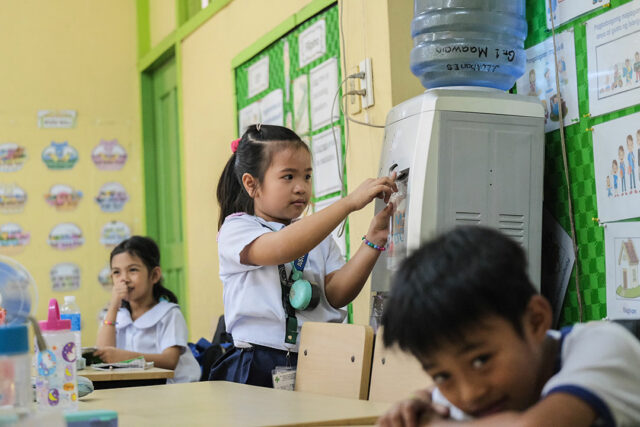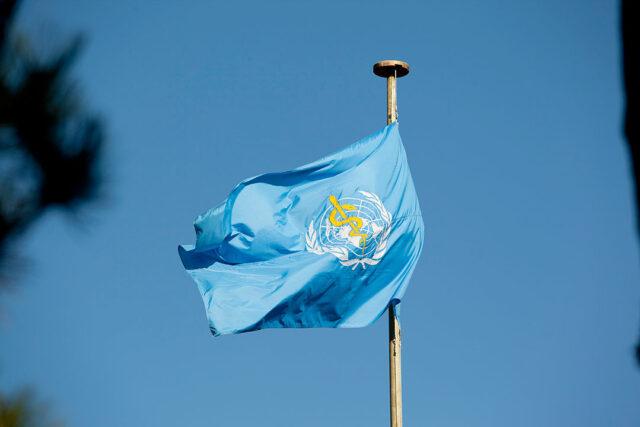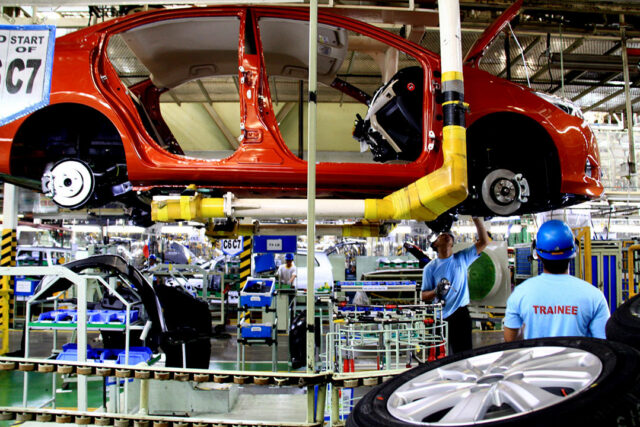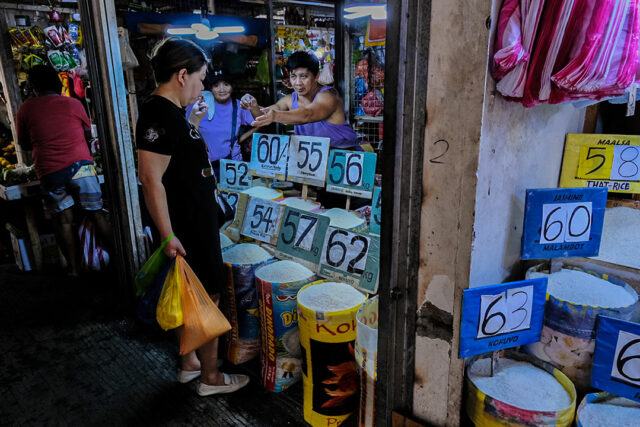By Kyle Aristophere T. Atienza, Reporter and Chloe Mari A. Hufana
ALEXANDER V. SUYAT, 36, trained to become a security guard in 2016 after years of working as a janitor, thinks he could earn more to support his wife and two kids.
He earns P610 ($10.59) for an eight-hour work shift — the minimum wage in the Philippine capital — and he has high hopes that the P150 legislated wage increase proposed in Congress would soon become a law.
“My salary goes to many things — food and school for my children,” he told BusinessWorld in Filipino while on a break. “Many say P150 is too small, but I’ll take it because it’s better than nothing.”
Mr. Suyat’s wife works as a saleslady in a nearby mall, and their income, which they try to increase by working overtime, is just enough for the family to get by. “Prices are so high now, it’s so hard to save even if you have a stable job.”
As the couple’s income lags, the cost of living keeps rising. Philippine inflation quickened for a second straight month in March as rice prices continued to surge. Inflation accelerated to 3.7% from 3.4% in February, according to the local statistics agency.
 The economy expanded by 5.5% last year and is expected to grow by 6-7% this year, still among the fastest in the region.
The economy expanded by 5.5% last year and is expected to grow by 6-7% this year, still among the fastest in the region.
Despite that strong growth, wages have remained flat, and workers are pressing the government of President Ferdinand R. Marcos, Jr. to increase wages nationwide in the face of spiraling prices.
Daily minimum wages in the Philippines, which vary per region, averaged P354.32 from 1989 until 2024, reaching an all-time high of P610 in Metro Manila last year and a record low of P89 35 years ago, according to Trading Economics, citing Labor department data.
The minimum wage in the southern Philippine region of Bangsamoro — the poorest in the country — ranged from P316 to P361.
“A P150 increase is welcome and gives some relief to workers and their families, but it doesn’t even restore wages to their level after the last legislated wage hike in 1989,” Jose Enrique “Sonny” A. Africa, executive director at think tank IBON Foundation, said in a Viber message.
“The P370-plus wage hikes since 1989 haven’t been enough to keep up with inflation and the real value of the minimum wage in all regions is worth less now than 35 years ago,” he added.
The country’s largest labor organization said the El Niño weather event and climate change “justify a wage increase, particularly in sectors most vulnerable to these changes.”
“Workers in agriculture, construction and other outdoor industries face increased health risks and disruptions to their work due to extreme weather conditions,” Federation of Free Workers Chairman Jose Sonny G. Matula said in a Viber message.
The Philippines adjusts salaries through its wage boards, but slow and meager increases against the backdrop of rising costs of living have prompted lawmakers under the Marcos administration to legislate wage increases.
At the House of Representatives, separate bills that seek to increase wages of private sector workers by P150 to P750 have been filed, as well as another that mandates a P33,000-a-month entry wage for government employees.
Senators, meanwhile, have approved a bill increasing the daily minimum wage in the private sector by P100 on second reading.
Government economic managers have warned of the consequences of legislating wage increases. National Economic and Development Authority Secretary Arsenio M. Balisacan last month said the Senate bill could cut economic output by 0.5 percentage point, stoke inflation and worsen joblessness.
The Philippine Chamber of Commerce and Industry (PCCI), the country’s largest business group, said the legislated wage hike would make it harder for companies to recover from the coronavirus pandemic and reverse business confidence.
“There were already positive signs from businesses, and confidence was gradually increasing after the pandemic,” PCCI Chairman George T. Barcelon said by telephone. He added that geopolitical tensions, persistently high inflation and the peso’s depreciation have dampened that optimism.
‘BARELY A DENT’
Mr. Barcelon said lawmakers should take into account an impending energy crisis in the whole wage hike debate as the country’s sole indigenous source of natural gas gets depleted by 2027.
“We suggest that the discussion on wage hikes be left to the Regional Tripartite Wages and Productivity Boards so that all stakeholders are represented to be able to balance the needs of workers, the capability of enterprises and varying conditions across industries and regions,” Ebb Hinchliffe, executive director of the American Chamber of Commerce of the Philippines, Inc. said in a Viber message.
British Chamber of Commerce Executive Director and Trustee Christopher James Nelson noted that while they understand workers’ predicament, in the end, inflation from wage hikes could bite them.
“We understand the concerns workers have, but inflation is a macroeconomic issue,” he said in a phone interview. “A wage hike in itself will have an inflationary impact, which will, again, impact workers.”
Mr. Nelson said persistently high inflation also keeps the Philippine central bank from cutting its benchmark interest rates, effectively increasing companies’ borrowing costs.
“Wage hikes won’t be inflationary if businesses aren’t so rigid about the profits they insist on making,” Mr. Africa said. “There are many factors causing inflation like the recent supply chain disruptions, commodity price fluctuations, currency depreciation and other external shocks. Undue alarmism about wage hikes is really just placing the burden of corporate profit-making on workers.”
A legislated wage hike would barely make a dent on corporate profits since salaries account for only as much as 11% of their expenses, Mr. Africa said, citing IBON’s study of a recent state-led annual survey of 38,000 companies of all sizes in all sectors.
“A P100 across-the-board wage hike is just 7.1% of profits on average across all firm sizes and 7.5% for micro, small and medium enterprises (MSME), while a P150 increase is just 11% across all firms and 11.3% for MSMEs,” he said.
“Even a P690 increase to raise the average wage to the current P1,207 family living wage is equivalent to just 49% of profits across all companies,” he added.
Economic managers and the business community have warned that a legislated wage hike would mainly affect MSMEs, which account for more than 99% of businesses in the country.
Mr. Africa and Mr. Matula said significantly increasing workers’ wages would boost their spending power, spurring economic activity and benefiting small businesses.
“Wage hikes are an opportunity for economic growth rather than a challenge,” Mr. Matula said. “They mean enhanced purchasing power for workers, who are also consumers. This is likely to benefit businesses, especially MSMEs.”
He said a P100 wage hike, representing a 16% raise based on Metro Manila’s minimum wage now, is not only manageable but also crucial to economic growth. “The P150 wage proposal represents 24.59% of the current P610 daily minimum wage in the National Capital Region, significantly lower than the 39.1% increase seen in 1989.”
Jenet I. Dacumos, a single mom of three who works as a janitress in a mall in Manila, is pessimistic about a legislated wage increase.
“I feel our President doesn’t empathize with the poor, so I don’t expect it to happen,” she told BusinessWorld while resting during her shift. “Food prices are driving me crazy. How can they expect us to live on P610 daily? I need another racket.”













 The economy expanded by 5.5% last year and is expected to grow by 6-7% this year, still among the fastest in the region.
The economy expanded by 5.5% last year and is expected to grow by 6-7% this year, still among the fastest in the region.